清華嵒午日鍾馗 軸
推薦分享
資源連結
連結到原始資料 (您即將開啟新視窗離開本站)後設資料
- 資料識別:
- 故畫000765N000000000
- 資料類型:
- 類型:繪畫
- 型式:靜態圖像
- 著作者:
- 華喦
- 主題與關鍵字:
- 奇石 楊柳 鍾馗 鬼怪 蜀葵 蝶蛾 石榴 傘 飲食器 傢俱(屏風) 池水
- 出版者:
- 數位化執行單位:國立故宮博物院
- 格式:
- 本幅 131.5x63.7公分、全幅 85.4公分
- 關聯:
- 石渠寶笈三編(延春閣),第五冊,頁2224&*故宮書畫錄(卷五),第三冊,頁555&*故宮書畫圖錄,第十一冊,頁151-152&*北宋沈括記唐太宗病中曾夢武舉落第之士鍾馗,為其捉鬼,醒後病除。唐代起盛行歲除時節懸掛鍾馗圖像驅邪避煞,明清時期此項風俗更擴及端午節慶。本幅鍾馗烏帽綠袍,品賞錦葵,身後案上設有果、酒、香粽等物。隨侍五鬼,其中一鬼竊橘欲藏腋下,另一鬼察覺。整幅兼具故事性與趣味性。作者華喦(西元一六八二-一七五六年),福建上杭人。字秋岳,號新羅山人。初寓杭州,後客居揚州鬻畫。(20091016) &*In the early Song, Shen Gua told of the unsuccessful military exam candidate Zhong Kui visiting the Tang emperor Taizong in his dream while ill, capturing demons and curing him. In the Tang it was popular to hang column images of Zhong Kui to expel demons and avert calamity. Later in the Ming and Qing, the custom spread to the Dragon Boat Festival. Here Zhong Kui wears a dark green cap and admires mallow blossoms. Fruit, wine, and dumplings are on the table behind him. Of the 5 demons, one has pilfered an orange under his arm, only to be discovered by another. This interesting work thus has a strong narrative quality. Hua Yan was a native of Shanghang, Fujian. He first lived in Hangzhou, later residing in Yangzhou to sell paintings.(20091016)&*Chung K’uei on the Double Fifth Hua Yen (1682-1756) Ch’ing Dynasty Hua Yen (style name Ch’iu-yüeh and sobriquet Hsin-luo shan-jen) was a native of Shang-hang, Fukien. He moved from Hangchou to Yangchou and made a living selling paintings. He excelled at figures, landscape, birds-and-flowers, and grasses-and-insects, rejecting contemporary manners in a search for ancient methods. In this painting is a scene with pomegranate blossoms, decorative rocks, and a willow by a cool pond. Chung K’uei is shown wearing a dark cap and a light green robe as he leans back on a low chair appreciating the beautiful scenery. On the table behind him are fruit, whine, rice dumplings, and other objects. Five demons are in attendance; one holds a tattered parasol against the sun, one in front brings a bowl of wine, and another wears a dark robe with a flower in his cap and is looking at something to his right. A darker-skinned demon has taken some fruit from the table and hid them under his arm. Having been caught by the demon behind, his cap has been removed and his head rapped suddenly. Surprised, he shirks in response with mouth agape and shoulders hunched. This interesting diversion adds to the narrative and provides comic relief to the more serious figure of Chung K’uei. &*1.劉芳如,〈清華喦午日鍾馗〉,收入國立故宮博物院編輯委員會編,《迎歲集福 — 院藏鍾馗名畫特展》(臺北:國立故宮博物院,1997年二月初版一刷),頁158-159。 &*華喦(西元一六八二-一七五六年),福建上杭人。字秋岳,號新羅山人。初寓杭州,後客居揚州鬻畫。兼善人物、山水、花鳥、草蟲,脫去時習,力追古法。 本幅畫榴花倚石,楊柳清池。鍾馗烏帽綠袍,據椅適坐,兀自品賞錦葵爭艷。身後案上,復設有果、酒、香粽等物。隨侍五鬼,一張破傘障日,一捧酒樽,一簪花於首。一則竊盤中廬橘而欲藏之腋下,另一鬼察覺,以左手攫去其巾,右手拳擊其頂。竊鬼縮頸吐舌,作驚怖之狀。通幅集故事性、趣味性於一紙,令觀者忍俊不禁。
- 管理權:
- 國立故宮博物院
授權聯絡窗口
- 國立故宮博物院圖像授權、出版授權、影音資料授權-申請流程說明
http://www.npm.gov.tw/zh-TW/Article.aspx?sNo=03003061






